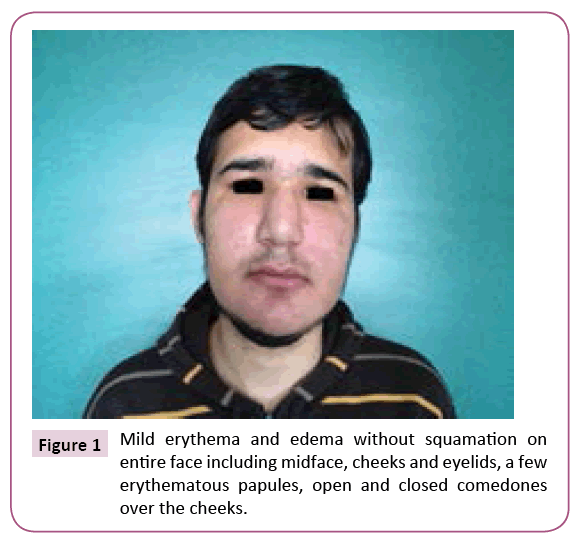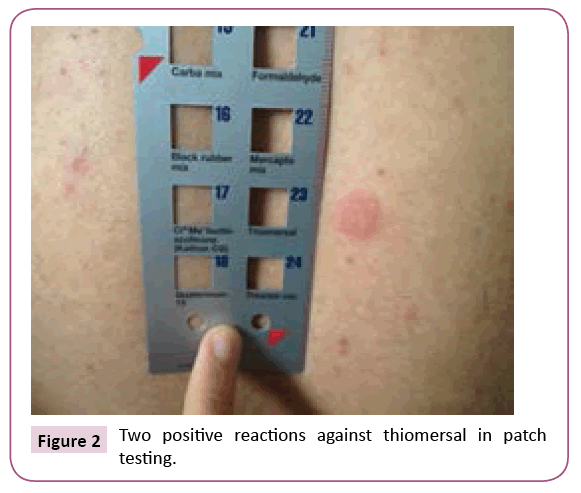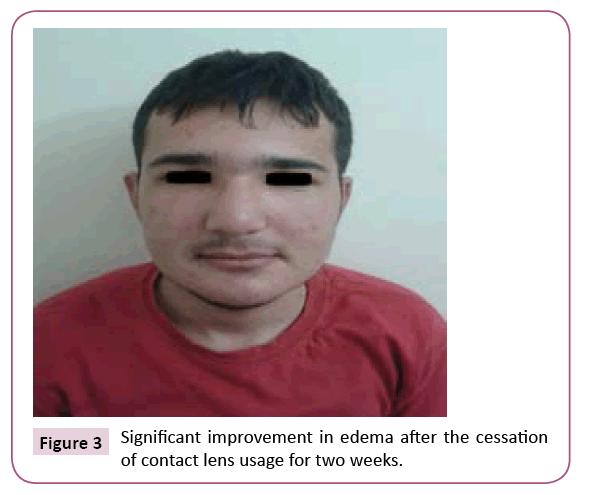Havva Ozge Keseroglu*, Müzeyyen Gönül, Hatice Ata?, Bengü Çevirgen Cemil and Can Ergin
Department of Dermatology, D??kap? Y?ld?r?m Beyaz?t Education and Research Hospital, Ankara, Turkey
- *Corresponding Author:
- Havva Ozge Keseroglu
Department of Dermatology, D??kap? Y?ld?r?m Beyaz?t Education and Research Hospital, Ankara, Turkey, Zip Code: 06110.,
E-mail: ozgederm@yahoo.com
Tel: 903125962000
Received Date:November 23, 2015; Accepted Date: December 21, 2015; Published Date: January 02, 2016
Citation: Keseroglu HO, Gönül M, Atas H, et al. A Case of Chronic Contact Dermatitis Causing Persistent Edema of the Face. Clin Pediatr Dermatol. 2016, 2:1. DOI: 10.21767/2472-0143.100009
Keywords
Persistent edema of face; Contact dermatitis
Introduction
Persistent edema of the face can be caused by a variety of diseases so difficulties in differential diagnoses may arise. Chronic contact dermatitis is an easily overlooked cause of persistent edema, especially if there is no eczematous lesion in the clinical setting [1].
Case
An 18-year old man attended to our clinic with asymptomatic swelling on his face. The swelling was utmost in the mornings, gradually diminishing towards midday but never disappearing completely. It was learned that the swelling first appeared on right cheek 1.5 years ago after dental abscess, than spread to both cheek and forehead. Although dental abscess healed after antibiotic treatment, the swelling of face persisted. There was no associated pruritus or another symptom and no history of trauma. He was treated with different systemic antihistamines and antibiotics (amoxicillin clavulanic acid, doxycycline) with no benefit within last one year. The systemic isotretinoin treatment was tried because of associated acne vulgaris but he could not tolerate it due to xerophthalmia.
Dermatological examination revealed mild erythema and painless edema without squamation on entire face including midface, cheeks, forehead and eyelids. In addition, there were a few erythematous papules, open and closed comedones over the cheeks (Figure 1). Fasting blood sugar, complete blood count, liver, kidney and thyroid function tests, serum angiotensin converting enzyme and complement levels were within normal limits. Antinuclear antibody test was negative. There was no pathological finding except mild increase in thickness of cutaneous and subcutaneous tissues on magnetic resonance imaging. No focal infection focus was detected on otolaryngology consultation. Histopathological examination of the biopsy taken from cheek revealed nonspecific findings including minimal spongiosis, perivascular lymphocytic infiltration and a few eosinophils in the dermis.
Figure 1: Mild erythema and edema without squamation on entire face including midface, cheeks and eyelids, a few erythematous papules, open and closed comedones over the cheeks.
Patch test was performed and two positive reactions was detected against thiomersal which can be found in contact lens solutions and eye cosmetics (Figure 2). In the detailed history we learned that he had been using contact lens for 8 years due to high degree myopia (-10.0/-13,0) and astigmatism(-0.75/-1.0). Edema was thought to occur as a result of contact dermatitis against contact lens solution which was containing thiomersal. Significant improvement in edema was achieved after the cessation of contact lens usage for two weeks (Figure 3). In spite of high degree of myopia and astigmatism, he could not be operated due to his young age and he could not use eye glasses because of deterioration in visual field. So, he restarted to use contact lens and edema of face increased rapidly again.
Figure 2: Two positive reactions against thiomersal in patch testing.
Figure 3: Significant improvement in edema after the cessation of contact lens usage for two weeks.
Discussion
Persistent edema of face can be caused by a wide range of diseases such as Melkersson-Rosenthal syndrome, sarcoidosis, dermatomyositis, lupus erythematosus, facial lymphedema, Morbihan disease, superior vena cava syndrome, hypothyroidism, chronic contact dermatitis, so that several investigations, also including invasive methods, are needed for differential diagnosis [1]. We eliminated the diagnosis of Melkersson-Rosenthal syndrome due to absence of concomitant recurrent facial paralysis and scrotal tongue. Histopathological and laboratory findings were not compatible with dermatomyositis and lupus erythematosus. There was no granuloma, dilated lymphatics and mononuclear inflammatory infiltration on histopathological examination so sarcoidosis and facial lymphedema were ruled out. Hypothyroidism was excluded by normal thyroid function tests. The diagnoses of chronic actinic dermatitis were eliminated due to young age, discordant histopathology and absence of eczematous eruption. Superior vena cava syndrome was ruled out due to absence of dilatation of neck veins and symptoms such as dyspnea, cough and difficulty in swallowing.
Allergic contact dermatitis was not thought in diagnosis primarily because of no concomitant eczematous lesions and pruritus, and no history of any topical agent usage on face region. Patch testing was performed because we could not clarify the etiology with other investigations and patient history. Two positive reactions against thiomersal were observed on patch test and the diagnosis of contact dermatitis against thiomersal was done. The regression of edema rapidly with discontinuing contact lens usage and recurrence after starting usage again supported our diagnosis.
Thiomersal, a one of the well-known sensitizing agents, is widely used in contact lens solution, eye cosmetics, vaccines and antiseptics as a preservative [2]. Nowadays, it was eliminated from the content of many topical preparations to decrease thiomersal exposure in the population. Despite this, recent 3 studies (two from Brazil and one from Saudi Arabia) showed us the continued high level of thiomersal sensitization in the population with 14.2- 16.2% positivity in patch testing [2-4].
The possibility of chronic contact dermatitis should be considered especially in persistent face edema with unknown etiology. These patients should be questioned in detail about the products they used and patch testing should be performed. Many unnecessary examinations may be prevented by this way.
References
- Wohlrab J, Lueftl M, Marsch WC (2005) Persistent erythema and edema of the midthird and upper aspect of the face (morbusmorbihan): evidence of hidden immunologic contact urticaria and impaired lymphatic drainage. J Am AcadDermatol52:595-602.
- Duarte IA, Tanaka GM, Suzuki NM, Lazzarini R, Lopes AS, et al. (2013) Patch test standard series recommended by the Brazilian Contact Dermatitis Study Group during the 2006-2011 period. An Bras Dermatol88:1015-1018.
- Almogren A, Shakoor Z, GadElRab MO, Adam MH(2012) Pattern of patch test reactivity among patients with clinical diagnosis of contact dermatitis: a hospital-based study. Ann Saudi Med 32:404-407.
- Rodrigues DF, Neves DR, Pinto JM, Alves MF, Fulgêncio AC (2012)Results of patch-tests from Santa Casa de Belo Horizonte Dermatology Clinic, Belo Horizonte,Brazil, from 2003 to 2010. An Bras Dermatol 87:800-803.




